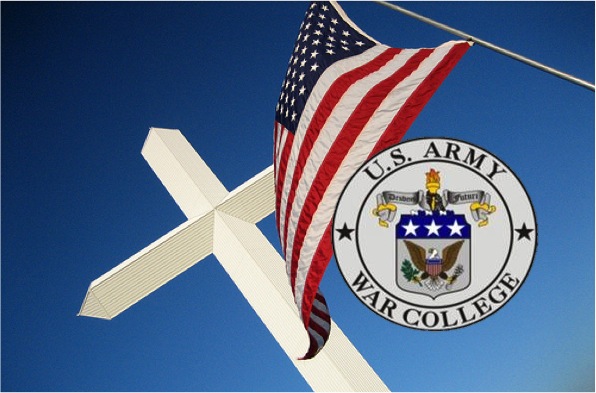War College thesis masks real issues with Victimhood campaign
A new ‘monograph’ by Don Snider and Al Shine has been published through the Army War College. This monograph proposes to review the role of personal beliefs (And expressions thereof) in the professional military ethic. More specifically, the authors analyze impacts and suggest resolution for “hostility” toward religion in the military. In reviewing the piece, I had hoped to see some interesting insights, concerning reports, or helpful suggestions. I was sadly disappointed to find a long list of non-issues and a lack of attention to real problems in this area that resulted in no useful contribution to the discussion.
Full Text: Shine-Snider-ArmyCulture
NOTE: This paper is an academic paper and not official policy. However, it was published through the Army War College in an official Army War College program by distinguished and respected authors. Neither academic freedom nor prior work justify giving a platform for what seems to be little more than a political attack on the Army.
Before continuing, I would like to thank the authors for recognizing several times the role of nonreligious and secular beliefs and values. While sidestepping the real disenfranchisement atheists and humanists suffer, the authors did recognize that we exist and restricted themselves to inclusive definitions of worldview and ethical frameworks. Such frameworks could be lifted out of context of the paper for beneficial use in the Army’s Spiritual Fitness and related values programs.
“It is our understanding that every Soldier has a personal morality that starts with what he or she believes to be good, right, and just. More specifically, it is: the worldview component of one’s human spirit, or personal essence. This system of beliefs defines who a person is, what the person stands for, serves as a guide for determining behavior—especially in ambiguous and chaotic situations—and also provides the courage and will to act in accordance with one’s beliefs and values.”
However, at base, the piece is clearly an addition to the ongoing campaign of Christian Victimhood that arises more from Christian politics than any non-Christian oppression. The report mentions “hostility” toward religion 24 times in just 41 pages of content. The examples of this assumed “hostility” are enumerated below (section 2). Just 9 examples of hostility, and only 2 of which are even remotely legitimate accusations. Such unjustified allegations of hostility have no real utility except to bolster the Christian victimhood complex, which continues to rely upon previously debunked allegations of religious persecution.
Directors at the War College introduce the monograph with this encouraging note: “This monograph is the 6th in the Professional Military Ethics Series; it addresses an issue about which little has been written. It intentionally plows new and difficult ground.” That may have been their hopes, but what they got was a shallow and political screed. Despite the directors’ confidence in their work, the authors wallow comfortably in perceived plight of the powerful Christian supermajority of our military. In that wallow, they almost entirely sidestep any real issues. In their topic area of personal beliefs and the professional ethic, I will suggest a few important topics they have missed:
- The desire of nontheists to benefit from or at least not be excluded and harmed by Army Spiritual Fitness training.
- The desire of Sikh Americans to practice their faith more freely in the Army
- The desire of Christians to express their faith and even proselytize without restriction
- The desire of Christians to disparage and ostracize gays and lesbians
These are real issues facing our military and should be addressed head-on not obliquely through reframed and trumped-up claims of ‘hostility’ toward ‘religion’ (by which they mean Christianity).
The paper revolves (distantly) around the truth that personal values can conflict with military law and duty. This is a well-known and long-standing reality military personnel handle with integrity and honesty. The authors suggest three solutions for those with conflicts. The first two suggestions are to (1) compromise one’s personal values or (2) to simply quit. The former option can be set aside as personal integrity is non-negotiable for our Soldiers. The latter option to quit can hopefully be avoided if we seek the authors’ preferred option: (3) working together to find a way to integrate personal beliefs in a way that promotes the professional military ethic. That question is still outstanding with no way forward explained by this paper.
Section II: Claims of Hostility
As listed above, the authors rely heavily on the unsupported assumption of hostility toward religion in the military. I noted nine (9) claims of hostility toward religion asserted by the authors. I elaborate here on the nine claims because the authors’ selections serve to discredit their objectivity on the issue of religion in the military. The authors’ selections are limited at best and more firmly disprove allegations of hostility toward religion.
1) DEOMI Extremist Groups: The Defense Equal Opportunity Management Institute and related agencies published a report listing Christians and Catholics as ‘extremist groups’. The report was quickly removed and recanted by the DoD. This is not ‘hostility toward religion’, it was a gaffe swiftly and clearly resolved. The authors even acknowledge that the ACLU hailed the removal of the Christian reference, so the authors seem to be grasping even with their first example. (pg 1)
2) Chaplain ownership of Religion: As Chief of Staff of the Air Force, General Norty Schwartz put out clear and firm instructions (Memo and AFI 1-1) that put religious programs firmly in the realm of the chaplaincy and discouraged command promotion of religion. This empowers chaplains and directs commanders back to the business of running the unit rather than preaching to the unit. While it was good policy, those who wish to have unfettered opportunity to promote their personal religious beliefs from a command position might consider it ‘hostility’ toward religion. (pg 10)
3) Patient proselytism: Walter Reed military hospital leadership decreed that civilians should not be able to enter a military hospital and hand Bibles to unsuspecting patients. The policy was buried, so Christians continue to be free to proselytize the ill and wounded. The policy never restricted the opportunity for patients to receive Bibles at their request. And this is related to civilians and patients not specifically military operations. This Bible Banning Caper entirely favors Christian proselytizing and can in no way be considered hostility. (pg 12)
4) Non-punishment of sharing faith: The authors reference a Department of Defense public affairs statement, which is hardly policy, that says the DoD allows members to share their faith. The authors ask ‘if religious expression within military cultures was not at issue, then why was such a directive needed?” It was not a directive but simply a public affairs statement reiterating policy. Furthermore, the statement was needed because the campaign of Christian Victimhood had created such a furor that the DoD felt obligated to allay their concerns with a clear statement. It is ironic that the authors ask why such a statement was necessary while recreating the same manufactured outrage that makes such consoling statements necessary. (pg 13)
5 & 6) Congressional attention: The authors present one point as two – a conscience protection clause proposed by Rep Fleming (R-LA) and opposed by President Obama. This is not evidence of a problem but an assertion, entirely unsupported, by Rep Fleming that there is a problem. President Obama, to his credit, recognized the lack of hostility toward religion and opposed the amendment as unnecessary. (pg 13)
7) Neutrality toward religion: A Christian cross and steeple was removed from an Army chapel in Afghanistan. This is existing policy, has always been in place, and is enforced just as any other policy. The authors should be taking to task those Christian chaplains attempting to co-opt general-use government buildings to promote their preferred religion. The authors also ask “should not the house of worship reflect the essential icons and artifacts of that particular group?” The answer is yes, and they do, temporarily, when they are using it for that particular worship service. The policy only restricts permanent fixtures, out of respect for diverse beliefs and the diverse uses of the government chapel facility. It strains credibility that the authors don’t have a clear understanding of the implementation and background of the policy. (pg 22)
8) False Reports: In a truly obscure reference, the authors suggest that the military chooses to keep up appearances rather than to present the truth in certain investigations. Their chosen example is the cover-up of the circumstances of Army Corporal Pat Tillman’s death. It’s unclear what this has to do with hostility toward religion; honesty is a secular and Army value. One investigator, Lt Col Kauzlarich, infamously expressed hostility towards Tillman’s atheist beliefs, so maybe the authors meant this to be an example of hostility towards atheists. In any case, Honesty is part of the Army Values so there should be no conflict unless someone has a religious belief that promotes dishonesty. (pg 22)
9) Gay Pride Month is presented as hostile to religion. This example actually addresses, if from the wrong direction, one of the real problems. The military does now in fact affirm gay and lesbian persons while certain Soldiers continue to harbor faith-based hostility towards gays and lesbians. Deciding how to handle such issues is an area ripe for discussion, and we should work together to find a workable compromise between ‘anti-gay troops should just quit’ and ‘the Army should celebrate Christians but not gays‘. In seeking that compromise, we should remember who is hostile toward whom. (pg 24)
So, of these 9 examples, we have 2 real issues upon which religion might be seen as restricted (2, 9) though it is easy to see justification for each of those restrictions. Of the other 7, there are 2 in which religion is protected and encouraged (1,4), one in which Christian overreach was curtailed to provided for the expression of other religious beliefs (7), 2 in which unsupported allegations were swept aside (5 & 6), and 1 odd diversion from the topic at hand. If this is all, what we see is a military quick to facilitate and even promote religious belief.
How does a Christian respect others (by not pushing their beliefs on everyone) and operate in the military team (without discriminating against gays)? These are the real issues this paper should be addressing. Only by setting aside contrived Christian Victimhood and the false flag of ‘religious freedom’ can Christians come to the aid of other Christians struggling live their faith and serve their country in a healthy way. Such attempts to accommodate Christianity would be under the rule of Christians who hold nearly every position of military power and among a Christian supermajority playing the role of victim. We should not forget those truly disenfranchised Soldiers – Humanists, Jews, Hindus, Sikhs, Muslims, and other minorities – who most urgently need support.
Reference:
Strategic Studies Institute and U.S. Army War College Press: A SOLDIER’S MORALITY, RELIGION, AND OUR PROFESSIONAL ETHIC: DOES THE ARMY’S CULTURE FACILITATE INTEGRATION, CHARACTER DEVELOPMENT, AND TRUST IN THE PROFESSION? by Don M. Snider and Alexander P. Shine
Snider / Shine Journal of Faith & War
http://faithandwar.org/index.php?option=com_content&view=article&id=128:the-right-to-be-wrong&catid=44:strategic-leadership&Itemid=55

